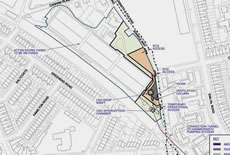Residents Concerns Over Super Sewer
Subsidence, Boring Machines and 10m Tall Ventilation Column
Consultation over the multi-billion pound Acton super-sewer project is underway and residents are expressing concerns about the potential for subsidence in properties under which the tunnel is being built.
Part of the project involves connecting the local combined sewer overflow (CSO) at the Warple Way site, leading to the main tunnel of the proposed Thames Tunnel project.
This will involve the building of a 2.6km tunnel which maps on the consultation document suggest will pass under Abinger Road, Welstead Way, Netheravon Road and Chiswick Mall.
Subsidence near two London tunnels constructed in the last decade has been revealed in images produced from satellite data.
The ground movement appears near London Underground's Jubilee line extension and a London Electricity tunnel.
"We are not saying this was definitely caused by the tunnels," says Mark Haynes, senior scientist for NPA Satellite Mapping, which created the images. But in terms of location, he says "there is a definite correlation". Experts say more research is needed to make a link between the tunnel building and the subsidence
Thames Water say their obligations have been met with two exhibitions – one in Acton Library and one in Linden House Hammersmith – and have declined repeated requests to hold one in Chiswick even though most of the tunneling for the pipe connecting the combined sewer overflows (CSO) to the main tunnel runs under W4.
The company identified Acton Storm Tanks as their preferred site. The site would be a construction site for approximately two years after which it would be vacated as much as possible but a smaller area kept secure for subsequent equipment installation. Construction traffic would enter and leave the site from temporary construction accesses off Warple Way, W3. Tunnel boring machines (TBMs) will be used to build both the main tunnel from west London to Abbey Mills or Beckton Sewage Treatment Works and the smaller connection tunnels to CSOs.
However, after two years of construction, residents will be left with the legacy of a number of ‘above-ground structures’ on this site including a 10m (33ft) high ventilation column as well as a kiosk housing electrical and control equipment. They may also need a ventilation building on the site.
Below is an example of how the Warple Way site could look after construction has finished.

Thames Water would like to know residents' views on the permanent look and use of the site at http://www.thamestunnelconsultation.co.uk/
It is from sites like the Acton Storm Tanks that untreated sewage is discharged directly into the river. Thames Water claim that London’s mainly Victorian sewerage system, which was designed to transport both sewage and storm water is at or near capacity. Some CSOs discharge untreated sewage into the River Thames on average more than once a week and after only 2mm of rainfall. This situation is likely to become worse in the future, due to population growth and increased urbanisation.
Thames Water hope to have planning approval by 2012 and aim to start work in 2013 with completion in 2020.
Related links
|
